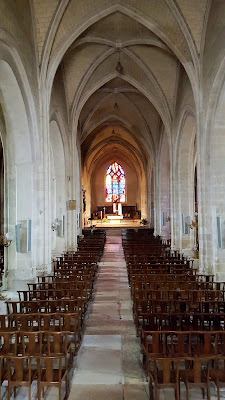If you're thinking that you've seen this church before . . . well, I can't really disagree with the sentiment.

The lavoir was somewhat interesting to see - a historical place where people went down to the river for washing. Too bad that people had defaced it with graffiti! I strategically shot these to exclude it, but it's truly unfortunate that people have so little regard for sites from history that cannot be replaced.
The next day I had planned to go to Futuroscope, but having ran out of time to see the Musée des Tumulus on Saturday, I decided I was more interested in doing that. I had thought it was in/near Poitiers, but it is actually near Bougon, which is about 30 minutes west of Poitiers . . . so my GPS wasn't taking me on some wild goose chase as I first thought when I crossed over N10 instead of getting *on* N10.
Musée des Tumulus de Bougon
Having clearly not looked into this well enough, I initially thought I was going to see stone age homes, but learned they were actually burial chambers. The site is a Neolithic necropolis dating from ~4,500 BC to 2,500 BC that was discovered in 1840. For being found so long ago, it was remarkably well-preserved! The tumuli of Bougon is the oldest Western European megalithic necropolis.
The attached museum includes a free English-translation head set for all of the signs, plus English translations of the videos that are shown AND the extra dialogue that French visitors can also get on a head set. I cruised through the various displays of tools pretty quickly - while I listened to most of the options, there were a few that were self-explanatory, even with French signs, and I skipped those. They had a very comprehensive display of ancient tools, which were displayed by type and perceived usage.
There were also full-size replications of a structure from three sites that have been found other places in the world, which you could enter and explore. This seemed like a great feature for kids! It was interesting even as an adult to walk inside while the headset explained what you were seeing. Even better, the place was nearly empty (although, that's unfortunate from the perspective of the place perhaps not being well-known/well-visited).
The tour then continues outside. There are a couple displays where they've shown how they currently believe the tumulus would have been built, given the tools available at the time, and a large replica of the type of house structures they believe were used based on findings. Then, you arrive at the main attraction - Tumulus! First, there is a very nicely preserved tumulu that makes for great photos . . . and you can go inside!
Feeling just slightly creeped out about being inside an ancient tomb right now . . .
It was interesting because each tumulu was slightly different with some much smaller (and more damaged) tumulus up next. The first one is still largely buried and inaccessible to the interior.
This one was more damaged, but gives a nice view of the interior structure:
This next photo is one end of the largest tumulu on the site - there is another mound similar to it at the other end. The middle chamber also had a few burials. You could enter these as well; however, going inside one creepy tomb was enough for me! The sheer size of this thing was impressive though - especially given how primitive the tools available at the time were, for them to move the massive stone blocks they used as the supports and the solid stone sheets used as the roofs would have taken immense effort.











No comments:
Post a Comment